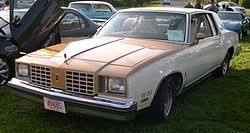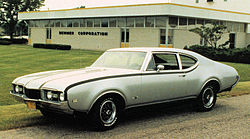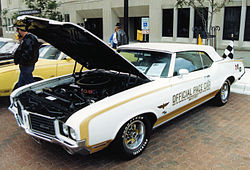Oldsmobile Hurst/Olds

Following the success of Hurst components in Oldsmobile's 442 models, Oldsmobile, in collaboration with Hurst Performance of Warminster, Pennsylvania, produced special-edition performance versions of the 442 or Cutlass Supreme, the Hurst/Olds.
1968

The first Hurst/Olds was the 1968 Hurst/Olds. It shared its body with the regular Oldsmobile Cutlass and 442, but had a unique Peruvian Silver and Black paint scheme. The Hurst/Olds was powered by a 390-horsepower W-45 (without A/C) or W-46 (with A/C) 455 cubic-inch Rocket V8. These engines were similar to the 400-horsepower W-34 455 engine offered in the Toronado and the 390-horsepower W-33 455 option available on the full-sized Delta 88. The W-45 and the milder W-46 engines differed in camshaft and cylinder head selection. The 455 was mated to a code OW three-speed Turbo Hydramatic 400 transmission with console-mounted Hurst Dual-Gate shifter that permitted automatic or manually ratched shifting.
515 production examples of the 1968 model were built in 2 body styles. There were 51 club coupes and 464 sport coupes manufactured.
The Hurst/Olds was the only GM intermediate-sized car to offer an engine larger than 400 cubic inches thanks to a corporate policy at that time which prohibited the divisions from putting larger engines in cars smaller than full-sized models other than the Chevrolet Corvette. Oldsmobile got around the 400 cubic-inch limit by implying that the engines were installed by Hurst, not Olds. In fact, the special drive train and ram-air package (shared with the W-30 and W-31) was installed at the factory. The cars were then taken across town (Lansing, MI) to Demmer Engineering where the remainder of the unique Hurst components were added. This included the black accent paint with hand-applied white pinstripes, the real walnut dash trim, H/O emblems, and of course the Dual Gate shifter and mini-console.
1969

The Hurst/Olds returned for the 1969 model year. The biggest change was the switch from the silver and black paint scheme of '68 to a new Firefrost gold on white paint scheme. This would be the primary paint scheme for many Hurst/Olds models of later years. Instead of the dual ram air scoops under the front bumper that was used in '68 and other ram air '69s, the H/O received a functional "mailbox" fiberglass hood scoop with H/O 455 on each side advertising what lurked under the hood. A spoiler was mounted on the trunk and the car sat on unique 15x7 chrome SSII rims with Goodyear F60x15 Polyglas tires. The exterior was finished off with a pair of English racing mirrors, H/O emblems on the front fenders and deck lid, blacked out 442 grilles, and black hand-applied pinstripes. All of the '68 and '69 H/Os were pinstriped by one guy! Interior modifications included the same dual/gate shifter setup as '68 (with different woodgrain), painted gold stripes on the headrests, and a Hurst/Olds emblem on the glove-box door. The non-drive train modifications were again done at Demmer Engineering. Approximately 913 cars were built including 2 convertibles for Hurst promotional use.
The 455 cubic-inch Rocket V8 received a slightly milder cam and produced 380 horsepower and 500 flbs of torque. This provided better drivability, particularly for air conditioned cars. The same engine was used for both A/C and non-A/C cars. The engine received a unique intake manifold, chrome steel valve covers, and a special vacuum operated air cleaner lid to allow cold air from the hood scoop into the carburetor. This was backed up by a specially calibrated code OH Turbo 400 transmission and 3.42 gears for non-A/C cars or 3.23 gears for cars with A/C. Optional 3.91 gears were available only for non-A/C cars.
The Hurst/Olds was temporarily dropped after the 1969 model year because GM dropped the 400 cubic-inch engine limit for the 1970 model year, which permitted the divisions to install larger engines in their intermediate musclecars. For 1970, the regular 442 came standard with a 365-horsepower 455 Rocket V8, or an optional 370-horsepower version of same engine with the W-30 option. For 1970, Olds planned to bring back the Hurst/Olds, but as a lower-priced companion to the 442 with a smaller 350 cubic-inch V8 and special graphics. That planned '70 H/O ended up being introduced as the mid-year Rallye 350, which featured a bright yellow paint scheme for the body along with front and rear bumpers coated with matching yellow urethane. The next Hurst/Olds would be introduced as a 1972 model.
1972

The 1972 Hurst/Olds was actually developed by Hurst Performance, and not Oldsmobile. Due to a tragic accident involving the 1971 Indy Pace car, a Dodge Challenger, the major auto manufacturers were reluctant to provide the pace car for the 1972 Indy race. Hurst Performance stepped up and volunteered to sponsor the 1972 Pace car. Oldsmobile provided the Cutlass Supreme coupe and convertible, and the rest is history. It was the first, and only time, an Indy Pace car was sponsored by a manufacturer other than an automobile manufacturer, and first time to include a major supplier's name in the title. There were a total of 629 made; 130 Convertibles, 220 hardtop with sunroof, and 279 hardtop cars. The only color available was Cameo White with reflective 3M gold stripes that were stickers, not paint. The standard Hurst/Olds engine was a 455 cubic-inch Rocket V8 rated at 270 net horsepower. Optional at extra cost was the W-30 option 455, a blueprinted engine rated at 300 net horsepower. Both engines were mated to a Turbo Hydra-matic 400 transmission with console-mounted Hurst Dual-Gate shifter.
1973
The Oldsmobile Cutlass (including the Hurst/Olds and 442) changed body styles to the "Colonnade" body style, which was used until 1977. The Hurst Olds was based on the semi-fastback Cutlass S coupe and featured an interior with swiveling Strato bucket seats separated by a console with Hurst Dual-Gate shifter for the Turbo Hydra-matic transmission. The sole engine offering was a 455 cubic-inch Rocket V8 with four-barrel carburetor and dual exhausts rated at 250 horsepower. The '73 model was the first Hurst Olds to be offered in two color schemes-black/gold or white/gold. A grand total of 1,097 Hurst/Olds were produced for 1973 with about 60% being white/gold and about 40% being black/gold.
1974
The Hurst/Olds returned in 1974 with the "Colonnade" body style. This year the Hurst/Olds was also the Indianapolis 500 pace car, which was available as a graphics package option to the Hurst/Olds owner. 1800 1974 Hurst/Olds' were produced in 1974, 380 of them were the W-30 version which designated the 455 cubic-inch Rocket V8 and produced 230 net horsepower. The other 1420 had a 350 cubic-inch Rocket V8 with 180 horsepower, which was also the only engine available for California cars. The 1974 Hurst/Olds was the pace car but the Indy 500 track required convertibles for the parade lap cars, the Delta 88 was chosen. These cars were used as track cars to parade celebities and guests on the track. There were a total of 92 Hurst/Olds Parade cars.
1975
The Hurst/Olds in 1975 was the first General Motors car to have "Hurst/Hatch" removable T-Top style roof installed. The car is based on the formal-roofed Cutlass Supreme coupe rather than the semi-fastback Cutlass S used in 1973-74. This roof design, early on was proven to be problematic, as at least two separate revisions exist for this roof in the form of redesigned seals and glass. The car was available in either black or white, with either a black or white half vinyl top offset by a wide aluminum band. Either a W-25, equipped with an Oldsmobile 350 engine, or a W-30, equipped with an Oldsmobile 455 engine could be had. Due the environmental regulations at the time, this was the first year that the EPA mandated the addition of catalytic converters mounted in the exhaust system. Due to the added expense, only single exhaust was available. The hood from the 1974 Hurst/Olds, with the center mounted louvers, carried over. Gold stripes adorned the sides of the car, as well as the trunk, hood, and mirrors. The car also carried gold 15"x7" Super Stock III Oldsmobile rims.
1979
Another car, now called simply the Hurst/Olds, appeared in 1979, based on the Cutlass Calais coupe. It used the L34, Oldsmobile's 5.7 L (350 in³) V8 engine. A Hurst Dual Gate shifter was standard. After a 3 year hiatus, the H/O returned in '79 on GM's newly downsized Cutlass body. The first H/O to be built entirely by Oldsmobile Division, it was also the first H/O that did not offer a 455 engine. But it was the only GM A-body to offer a 350 V8 in '79. White and black again were the color choices, but with a wider choice of interior trims than ever before. Gold paint covered the hood, most of the top, and the very rear of the trunk. The aluminum wheels were also painted gold, along with the grille. This H/O was built by Oldsmobile at the Lansing plant and didn't get sent off for additional work at Hurst Performance Products or Cars and Concepts. For this reason, there would be no possible loophole around the then current EPA regulations. In part and summary, those regulations stated that as long as an engine/transmission combination had been certified in any production model for that year, the same combination could be used in any other model that the factory desired, so long as less than 2,500 were produced. If 2,500 or more were built, the engine/transmission combination had to be certified specifically in that particular model. The "R" code Olds 350 engine in combination with the TH-350 transmission had already been certified in the 88 models for 1979, so legally that same combination could also be used in the Cutlass body without specific certification as long as less than 2,500 were built. That's why 2,499 1979 Hurst/Oldsmobile's were produced. Now, there were no 350/4 speed combinations already certified by Oldsmobile in 1979, so certification would have been necessary.
Known as the W-30, it was produced for the following year in the 1980 Olds 442.
1983-84

After the Cutlass line was split between the front-wheel drive A-body Cutlass Ciera and the rear-wheel drive G-body Cutlass Supreme in 1982, GM again offered a limited-edition Hurst/Olds - it was the 15th anniversary of the first Hurst/Olds introduced in 1968. The Hurst Lightning Rod floor shifter was introduced in the '83 H/O. For it's 15th Anniversary Edition, the '83 H/O came only in black with silver rocker panels. Chrome 15" wheels fitted Goodyear GT tires, and a power bulge hood and rear spoiler gave the car a purposeful look. A modified version of Oldsmobile's 307 CID V8 was installed, along with 3.73 gears and Hurst's radical Lightning Rods shifter. Dual exhausts with rumbling mufflers meant there was no mistaking the H/O for a garden variety Cutlass. A new style "Hurst/Olds" emblem was introduced, and red and silver stripes separated the black and silver paint. Demand for the car was very strong. Originally, 2500 units were scheduled to be produced, but Olds had to up that number to 3001 because of high demand. That may have been a factor in bringing the H/O back for '84. The paint scheme was reversed, with silver being the main body color, and black on the rocker panels. In most respects, the '84 was mechanically identical to the '83. The '84 did get a stronger 8.5" rear end.
External links
- The Oldsmobile Connection - The Site For Oldsmobile Enthusiasts
- The Hurst/Olds Club of America
- OldsGmail.com - The Home of the Oldsmobile G-Body Mailing List
www.Oldspower.com
